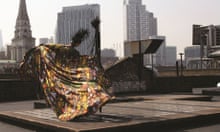Yes: Zandra Rhodes
I think fashion is an art form - you might call it decorative or applied art as opposed to fine art, but what's the distinction? Because the same amount of artistic expression goes into clothes, a piece of pottery or a painting. I've founded a museum on the basis that I think it's an artistic form that should be remembered. I think fashion galleries - such as the one at the V&A and the one at the Metropolitan in New York - are very relevant.
Fashion can tell you what people wore at a certain period just as pottery can tell you what their tea parties were like. I don't think the fact that these things were designed to be practical distinguishes them from fine art. You could say a painting is designed to go on the wall, but if it were made as a fresco, where it was part of the wall, would you say it was not art because it was practical?
Fine art at the moment is no longer particularly concerned with beauty, so you could say that fashion - which is always about a concept of beauty, whether or not everyone agrees on the concept - is more relevant, more artistic, than the garbage they put out as conceptual. If you look at it that way, fine art may go by the wayside, and fashion, which has a bit more effort put into it, will take over.
Some designers are directly influenced by fine art - a lot of Bill Gibb's things were influenced by the slashed panels in dresses in, say, Flemish paintings. I myself once designed something called the Venus dress which was somewhat influenced by Botticelli, though I haven't really gone too much in that direction. But when I see my clothes in my museum I don't feel any differently from how I felt about them at the time - I see that I believed in what I did with them, that they were the right thing to do.
Ossie Clark would have argued that fashion was art - he definitely thought his contribution was worthwhile, and his clothes were being shown in museums even at the time. He certainly would have expected them to be in museums now.
· The Zandra Rhodes Fashion and Textile Museum in Bermondsey, London SE1, which contains works by Ossie Clark as well as 3,000 of Rhodes's own designs, is open Tuesday to Sunday, 11am to 5:45pm
No: Alice Rawsthorn
On a trip to Paris, the New York fashion designer Donna Karan was dragged off to the Picasso Museum by her late husband, Stephen Weiss. He hoped that his wife would love it as much as he did. Instead, or so he told American Vogue, she dashed at speed from gallery to gallery barely pausing to look at the works.
Suddenly Weiss heard Donna screaming with glee in another gallery. At last, he thought, she has finally found a Picasso that inspires her. He ran into the gallery only to discover his wife gazing at a bare expanse of green wall. This particular shade of green, she explained breathlessly, would be perfect for next season's lingerie.
Now, this story tells us a great deal about Donna Karan, not least that she is refreshingly free from pretentiousness and pomposity when it comes to her chosen field. You can't help wondering whether, if you asked Donna 'Is fashion art?', her response would be the style slut's equivalent of former Liverpool manager Bill Shankley's proclamation: 'Some say football is a matter of life and death - I'd say it's much more important than that.'
Quibbling over whether fashion is more or less important than art is just as pointless as questioning whether or not it is art. Of course it's not, it's fashion. That is not to say that fashion, at its best, is not a suitable subject for museums or that it cannot share some of the attributes of art. On the contrary, an exquisite haute couture dress - like the ones that Cristóbal Balenciaga created in his 1950s heyday - can look as perfect as a beautiful painting or sculpture.
Yet only an old-fashioned aesthete would argue that the role of the artist is to create beauty. Sometimes artists do, but for most of them beauty tends to be a by-product of their quest to explore the complex, messy, ambiguities of modern life. Think of Wolfgang Tillmans's photographs of areroplane wings and window sills now on display at Tate Britain. Beautifully composed they may be, but with a forlorn beauty too subtle to be replicated in fashion.
Similarly, fashion is adept at fulfilling another traditional function of art by reflecting changes in contemporary culture, but only up to a point. Think of how the Ossie Clark dresses in the V&A's exhibition evoke the desire for escapism at the turn of the 1970s. Yet, unlike art, fashion rarely expresses more than the headlines of history.
And fashion has a practical purpose, whereas art does not. The result may be as gorgeous as a vintage Balenciaga ballgown or an eloquent political metaphor for its time, but it is still an item of clothing intended to be worn. Why pretend that it is anything else?
· Alice Rawsthorn is director of the Design Museum




